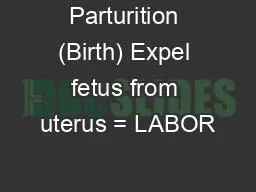

Last few weeks of pregnancy estrogen levels peak myometrium forms oxytocin receptors Interrupts progesterone allows small uterine contractions false labor Braxton Hicks Oxytocin production causes placenta to release prostaglandins more powerful contractions ID: 784961
Download The PPT/PDF document "Parturition (Birth) Expel fetus from ute..." is the property of its rightful owner. Permission is granted to download and print the materials on this web site for personal, non-commercial use only, and to display it on your personal computer provided you do not modify the materials and that you retain all copyright notices contained in the materials. By downloading content from our website, you accept the terms of this agreement.
Slide1
Parturition (Birth)
Expel fetus from uterus = LABOR
Last few weeks of pregnancy, estrogen levels peak:
myometrium forms oxytocin receptors
Interrupts progesterone, allows small uterine contractions (false labor, Braxton Hicks)
Oxytocin production causes placenta to release prostaglandins = more powerful contractions
Slide2Positive Feedback Loop
Hypothalamus activated by increasing pressure levels on the cervix
Activates pituitary to release more OXYTOCIN…
Slide3Three Stages of Labor: DIALATION
True contractions dilates cervix 1 to 10 cm
Contractions
Increase from weak to vigorous
Regular
Upper uterus downwards to birth canal
Soften cervix: effaces6-12 hours
Slide4Three Stages of Labor: EXPULSION
Delivery of infant out of vagina
Mother’s response is to push
Infant is facing downwards: vertex, if butt down: breech
Mucus is suctioned before full delivery – baby begins to breathe
Complications (dropping oxygen levels or heart rate in infant) overcome by forceps, vacuum or Cesarean section
Slide5Three Stages of Labor: PLACENTAL
Uterine contractions compresses blood vessels
Placenta detaches
Afterbirth = placenta, fetal membranes and umbilical cord
Need to remove all tissues – could cause excess bleeding
Slide6Anatomical Changes
Uterus stretches to occupy most abdominal cavity
Ribs flare (shortness of breath, but vital capacity increases)
Lordosis – lumbar curvature (back aches)
Relaxin
causes pelvic ligaments and pubis to widen/relax (duck walk)
Slide7Physiological Changes
Estrogen/progesterone surge (morning sickness
)
Organ displacement = pressure on
esophagus,
stomach, and intestines (heartburn, small meals, constipation
)Excess waste from fetus and limited room (frequent urination…uncontrollable)
Blood volume increases up to 40% , blood pressure and pulse rate increases (swelling = edema)
Slide8Mammary Glands
Developmentally they are modified sweat glands
Present in both sexes, but only functional in females
Increase in size during puberty due to increased hormone levels (mostly estrogen)
Contain lobes (sections) which contain lobules (smaller chambers) which house clusters of alveolar glands.
Prolactin along with other hormones trigger milk production
Slide9Mammary Glands
Areola
– Pigmented area around nipple.
Nipple
- Protrudes from center of breast.
Alveolar glands
- Produce milk when a woman is lactating.Lactiferous ducts
- carry the milk from the alveolar glands through the nipple to the outside.